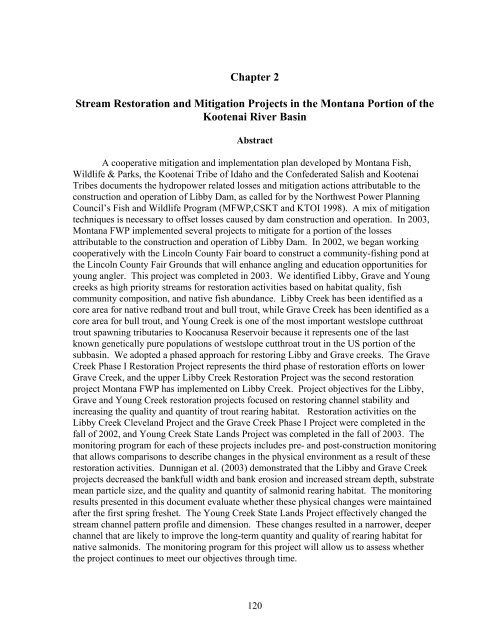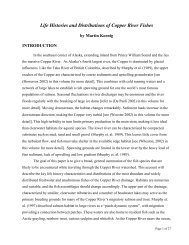Mitigation for the Construction and Operation of Libby Dam
Mitigation for the Construction and Operation of Libby Dam
Mitigation for the Construction and Operation of Libby Dam
You also want an ePaper? Increase the reach of your titles
YUMPU automatically turns print PDFs into web optimized ePapers that Google loves.
Chapter 2<br />
Stream Restoration <strong>and</strong> <strong>Mitigation</strong> Projects in <strong>the</strong> Montana Portion <strong>of</strong> <strong>the</strong><br />
Kootenai River Basin<br />
Abstract<br />
A cooperative mitigation <strong>and</strong> implementation plan developed by Montana Fish,<br />
Wildlife & Parks, <strong>the</strong> Kootenai Tribe <strong>of</strong> Idaho <strong>and</strong> <strong>the</strong> Confederated Salish <strong>and</strong> Kootenai<br />
Tribes documents <strong>the</strong> hydropower related losses <strong>and</strong> mitigation actions attributable to <strong>the</strong><br />
construction <strong>and</strong> operation <strong>of</strong> <strong>Libby</strong> <strong>Dam</strong>, as called <strong>for</strong> by <strong>the</strong> Northwest Power Planning<br />
Council’s Fish <strong>and</strong> Wildlife Program (MFWP,CSKT <strong>and</strong> KTOI 1998). A mix <strong>of</strong> mitigation<br />
techniques is necessary to <strong>of</strong>fset losses caused by dam construction <strong>and</strong> operation. In 2003,<br />
Montana FWP implemented several projects to mitigate <strong>for</strong> a portion <strong>of</strong> <strong>the</strong> losses<br />
attributable to <strong>the</strong> construction <strong>and</strong> operation <strong>of</strong> <strong>Libby</strong> <strong>Dam</strong>. In 2002, we began working<br />
cooperatively with <strong>the</strong> Lincoln County Fair board to construct a community-fishing pond at<br />
<strong>the</strong> Lincoln County Fair Grounds that will enhance angling <strong>and</strong> education opportunities <strong>for</strong><br />
young angler. This project was completed in 2003. We identified <strong>Libby</strong>, Grave <strong>and</strong> Young<br />
creeks as high priority streams <strong>for</strong> restoration activities based on habitat quality, fish<br />
community composition, <strong>and</strong> native fish abundance. <strong>Libby</strong> Creek has been identified as a<br />
core area <strong>for</strong> native redb<strong>and</strong> trout <strong>and</strong> bull trout, while Grave Creek has been identified as a<br />
core area <strong>for</strong> bull trout, <strong>and</strong> Young Creek is one <strong>of</strong> <strong>the</strong> most important westslope cutthroat<br />
trout spawning tributaries to Koocanusa Reservoir because it represents one <strong>of</strong> <strong>the</strong> last<br />
known genetically pure populations <strong>of</strong> westslope cutthroat trout in <strong>the</strong> US portion <strong>of</strong> <strong>the</strong><br />
subbasin. We adopted a phased approach <strong>for</strong> restoring <strong>Libby</strong> <strong>and</strong> Grave creeks. The Grave<br />
Creek Phase I Restoration Project represents <strong>the</strong> third phase <strong>of</strong> restoration ef<strong>for</strong>ts on lower<br />
Grave Creek, <strong>and</strong> <strong>the</strong> upper <strong>Libby</strong> Creek Restoration Project was <strong>the</strong> second restoration<br />
project Montana FWP has implemented on <strong>Libby</strong> Creek. Project objectives <strong>for</strong> <strong>the</strong> <strong>Libby</strong>,<br />
Grave <strong>and</strong> Young Creek restoration projects focused on restoring channel stability <strong>and</strong><br />
increasing <strong>the</strong> quality <strong>and</strong> quantity <strong>of</strong> trout rearing habitat. Restoration activities on <strong>the</strong><br />
<strong>Libby</strong> Creek Clevel<strong>and</strong> Project <strong>and</strong> <strong>the</strong> Grave Creek Phase I Project were completed in <strong>the</strong><br />
fall <strong>of</strong> 2002, <strong>and</strong> Young Creek State L<strong>and</strong>s Project was completed in <strong>the</strong> fall <strong>of</strong> 2003. The<br />
monitoring program <strong>for</strong> each <strong>of</strong> <strong>the</strong>se projects includes pre- <strong>and</strong> post-construction monitoring<br />
that allows comparisons to describe changes in <strong>the</strong> physical environment as a result <strong>of</strong> <strong>the</strong>se<br />
restoration activities. Dunnigan et al. (2003) demonstrated that <strong>the</strong> <strong>Libby</strong> <strong>and</strong> Grave Creek<br />
projects decreased <strong>the</strong> bankfull width <strong>and</strong> bank erosion <strong>and</strong> increased stream depth, substrate<br />
mean particle size, <strong>and</strong> <strong>the</strong> quality <strong>and</strong> quantity <strong>of</strong> salmonid rearing habitat. The monitoring<br />
results presented in this document evaluate whe<strong>the</strong>r <strong>the</strong>se physical changes were maintained<br />
after <strong>the</strong> first spring freshet. The Young Creek State L<strong>and</strong>s Project effectively changed <strong>the</strong><br />
stream channel pattern pr<strong>of</strong>ile <strong>and</strong> dimension. These changes resulted in a narrower, deeper<br />
channel that are likely to improve <strong>the</strong> long-term quantity <strong>and</strong> quality <strong>of</strong> rearing habitat <strong>for</strong><br />
native salmonids. The monitoring program <strong>for</strong> this project will allow us to assess whe<strong>the</strong>r<br />
<strong>the</strong> project continues to meet our objectives through time.<br />
120
















